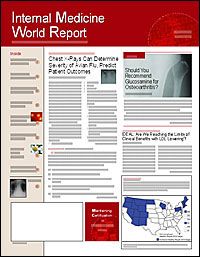Publication
Article
Internal Medicine World Report
What's New in Sinusitis Diagnosis and Management?
Dr Slavin outlined some of the major advances in sinusitis diagnosis and management that have emerged since the previous sinusitis guidelines appeared in 1998.
• We now recognize that the majority of upper respiratory infections are viral in nature and that bacterial sinusitis is being overdiagnosed. We urge a 7- to 10-day course of watchful waiting for spontaneous resolution of symptoms before prescribing antibiotics.
Exceptions would be patients with severe signs and symptoms of sinusitis regardless of duration of illness. These include worsening symptoms after 3 to 5 days, temperature greater than 39°C, maxillary tooth or facial pain, unilateral sinus tenderness, and periorbital swelling.
• Overuse of antibiotics has resulted in an alarming incidence of bacterial resistance, including 25% to 50% of Strep­tococcus pneumoniae being resistant to penicillin and an increasing (up to 25%) incidence of macrolide resistance. There appears to be wide geographic variation.
• Although the diagnosis of sinusitis is largely made on the basis of history and physical examination, there may be indications for sinus imaging. Because of cost and time considerations, standard radiographs were preferable to CT. More recently, a limited 4- to 5-mm cut coronal sinus CT is available at a cost similar to that of a set of standard radiographs. CT typically takes only 15 to 20 minutes and provides much better resolution of bone and soft tissue detail including the ethmoids.
• Obtaining a sinus culture was previously only by an antral puncture. There is evidence now that adequate secretions from the sinus can be obtained by an endoscopically directed catheter.
• Fungal sinusitis should be a consideration in cases of sinusitis that do not respond to appropriate antibiotics, particularly with accompanying nasal polyps.
• Gastroesophageal reflux disease (GERD) appears to be an underlying risk factor for sinusitis. There is evidence both in children and adults that appropriate medical therapy for GERD results in improvement in sinusitis.
• We have long recognized an association between sinusitis and asthma. There is suggestive evidence in children and adu­lts that appropriate medical and/or surgical treatment of sinusitis may result in an improvement in the asthmatic state.
• Functional endoscopic sinus surgery is now the surgical treatment of choice.
• Chronic sinusitis may be divided into an infectious form and a more common non­­infectious form, chronic hyper­plastic sinusitis, which does not respond to anti­bio­tics.






